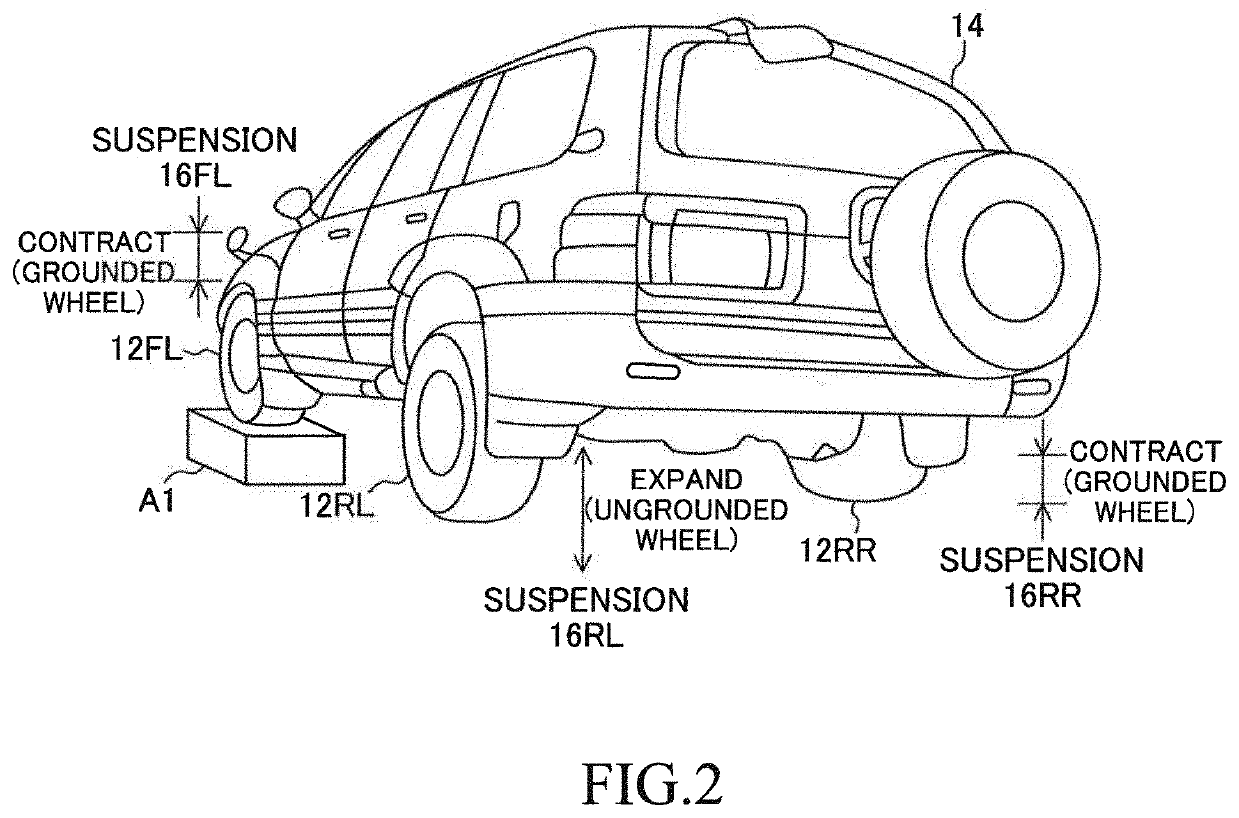Damping force control device
a control device and force technology, applied in the direction of braking system, control system, braking components, etc., can solve the problems of insufficient damped/attenuated damp/weakening impact, and inability to attenuate/reduce the vibration of the vehicle body
- Summary
- Abstract
- Description
- Claims
- Application Information
AI Technical Summary
Benefits of technology
Problems solved by technology
Method used
Image
Examples
first embodiment
(Configuration)
[0035]As shown in FIG. 1, a damping force control device 10 (hereinafter, referred to as a “first device”) according to a first embodiment is applied to a vehicle 14 comprising a front left wheel 12FL, a front right wheel 12FR, a rear left wheel 12RL, and a rear right wheel 12RR. Each of the front left wheel 12FL and the front right wheel 12FR is a steered wheel, and each of the rear left wheel 12RL and the rear right wheel 12RR is a non-steered wheel. The front left wheel 12FL and the front right wheel 12FR are suspended from a vehicle body 18 by suspensions 16FL and 16FR, respectively. The rear left wheel 12RL and the rear right wheel 12RR are suspended from the vehicle body 18 by suspensions 16RL and 16RR, respectively. Hereinafter, when the front left wheel 12FL, the front right wheel 12FR, the rear left wheel 12RL, and the rear right wheel 12RR do not need to be distinguished from each other, they are referred to as “wheels 12”. When the suspension 16FR through 1...
second embodiment
[0078]The damping force control device (hereinafter, referred to as a “second device”) according to a second embodiment will next be described. The second device differs from the first device in that the second device determines whether each of the wheels 12FL through 12RR is the ungrounded wheel or the grounded wheel, based on (using) the corresponding one of the rotation speeds Vi. Hereinafter, the above difference point will be described mainly.
[0079]The CPU of the suspension ECU 28 of the second device is configured to execute a routine represented by a flowchart shown in FIG. 5, in place of the routine represented by the flowchart shown in FIG. 3, every time a predetermined time period elapses. In FIG. 5, the same Steps as the Steps shown in FIG. 3 are denoted with common step symbols for the Steps shown in FIG. 3, and description thereof is omitted.
[0080]When a predetermined timing has come, the CPU starts processes from Step 500. When the vehicle speed Vs is equal to or lower...
modification example of second embodiment
[0090]The CPU according to this modification example calculates an estimation rotation speed Vb instead of the average rotation speed Va at Step 510. In more detail, an unillustrated shift position sensor transmits a signal indicative of a position of an unillustrated shift lever operated by the driver to the suspension ECU 28. An unillustrated drive ECU transmits a signal indicative of a gear position realized / set by an unillustrated transmission of the vehicle 14 to the suspension ECU 28. Furthermore, an engine rotation sensor transmits a signal indicative of a rotation speed of an engine which is a driving source of the vehicle 14 to the suspension ECU 28.
[0091]At Step 510, the CPU calculates the estimation rotation speed Vb of the wheels 12 based on “a gear ratio identified by the gear position” and the engine rotation speed. Furthermore, at Step 510, the CPU acquires the subtraction value Di by subtracting the estimation rotation speed Vb from the rotation speed Vi of each of t...
PUM
 Login to View More
Login to View More Abstract
Description
Claims
Application Information
 Login to View More
Login to View More - R&D
- Intellectual Property
- Life Sciences
- Materials
- Tech Scout
- Unparalleled Data Quality
- Higher Quality Content
- 60% Fewer Hallucinations
Browse by: Latest US Patents, China's latest patents, Technical Efficacy Thesaurus, Application Domain, Technology Topic, Popular Technical Reports.
© 2025 PatSnap. All rights reserved.Legal|Privacy policy|Modern Slavery Act Transparency Statement|Sitemap|About US| Contact US: help@patsnap.com



